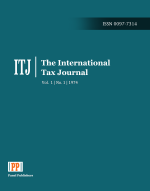Impact of the exchange rate on the economy
Keywords:
Consumption Expenditure, Exchange Rate, Export Competitiveness, Labor Productivity, Foreign Tourist Arrivals, Managed-Floating RegimeAbstract
It analyzes the effects of changes in the exchange rate of the Rupee–Dollar on major economic statistics in India during the period from 2019 to 2024, including export earnings, household spending, productivity levels and numbers of tourists from abroad. The study looks at secondary data obtained from the Reserve Bank of India, Department of Commerce, CEIC and Ministry of Tourism to run trend and regression analyses which analyze the impact of currency depreciation and appreciation on the Indian economy. According to the study, creating a managed-floating exchange rate system and making skill, manufacturing and tourism infrastructure more effective helps the country avoid risks and promotes stable growth.
Downloads
References
Acemoglu, D., S. Naidu, P. Restrepo, and J. A. Robinson (2019). Democracy does cause growth. Journal of Political Economy 127 (1), 47–100.
Bordo, M. D., C. M. Meissner, and D. Stuckler (2010). Foreign currency debt, financial crises and economic growth: A long-run view. Journal of International Money and Finance 29 (4), 642–665.
Prasad, E. S., R. G. Rajan, and A. Subramanian (2007). Foreign capital and economic growth. National Bureau of Economic Research, Working Paper, No. 13619 , 1–64.
Rajan, R. and L. Zingales (1998). Financial development and growth. American Economic Review 88 (3), 559–586.
Rohn, O., A. C. S´anchez, M. Hermansen, and M. Rasmussen (2015). Economic resilience: A new set of vulnerability indicators for OECD countries. OECD Economics Department, Working Paper, No. 1249 , 1–41.
Oskooee M. B., Kutan A. M. and Xi D. (2015) ‘Does exchange rate volatility hurt domestic consumption? Evidence from emerging economics.’, Science Direct 144, pp. 53-65.
Sebastian E. (2007) ‘Capital Controls, Capital Flow Contractions and Macroeconomics Vulnerability.’, ProQuest, Available at: https://search-proquest-com.ezproxy.nottingham.edu.cn/docview/1688669359?rfr_id=info%3Axri%2Fsid%3Aprimo (Accessed at: 27 February 2019)
Thorbecke W. and Kato A. (2011) ‘The effect of exchange rate changes on Japanese consumption export.’, Science Direct 24(1), pp. 64-71.
Tung L. T. (2019) ‘Does exchange rate affect foreign tourist arrivals? Evidence in an emerging tourist market.’, Management Science Letters 9(8), pp. 1141-1152, doi: 10.5267/j.msl.2019.5.00
Jeanneney S. G. and Hua P. (2010) ‘How does real exchange rate influence labour productivity in China?’, Science Direct 22(4), pp. 628-645.
Mathias K. (2015) ‘The exchange rate effect.’, ProQuest, Available at:https://searchproquestcom.ezproxy.nottingham.edu.cn/docview/1684299059/fulltextPDF/30A6BD600C6446BPQ/1?accountid =16676 (Accessed at: 27 February 2019)
Oskooee M. B., Kutan A. M. and Xi D. (2015) ‘Does exchange rate volatility hurt domestic consumption? Evidence from emerging economics.’, Science Direct 144, pp. 53-65. 5.
Sebastian E. (2007) ‘Capital Controls, Capital Flow Contractions and Macroeconomics Vulnerability.’, ProQuest, Available at: https://search-proquest- com.ezproxy.nottingham.edu.cn/docview/16886693 59?rfr_id=info%3Axri%2Fsid%3Aprimo (Accessed at: 27 February 2019)
Downloads
Published
How to Cite
Issue
Section
License
Copyright (c) 2025 The International tax journal

This work is licensed under a Creative Commons Attribution-NonCommercial-NoDerivatives 4.0 International License.








